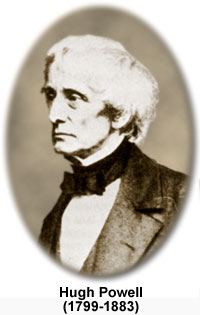Hugh Powell
(1799-1883)

Hugh Powell was born in London, England in 1799. Not much is known about Powell's early years, except that he had been producing microscopes for Andrew Pritchard since the 1830's when he formed a partnership with his brother-in-law, Peter H. Lealand in 1841. The firm, named Powell & Lealand, remained a major manufacturer of microscopes throughout the nineteenth century.
Powell was a pioneer of using very high powers in objective lens systems and advanced microscope design. Before 1831 he had made significant improvements in microscope design with the first of three microscopes produced for watercolor painter Cornelius Varley. The most advanced feature of this microscope was a revolutionary design in the spring action incorporated into the fine adjustment to prevent back-lash when the motion is reversed.
In 1841 the Microscopical Society of London commissioned Powell to produce a standard instrument according to their own design. Powell delivered the microscope to the society in December of 1841, and it is still in the possession of the society today. Another microscope produced by Powell in 1841 was radically different from the one delivered to the Microscopic Society. This microscope was illustrated and described in Daniel Cooper's, The Microscopic Journal and Structural Record for 1841. The article, entitled "Messrs. Powell and Lealand's Newly-Constructed Achromatic Microscope", describing this microscope was probably the first occasion on which the names of Hugh Powell and Peter H. Lealand were linked together. Cooper added a foot note:
"Mr. Lealand, Mr. Powell's brother-in-law, has for some years been engaged with him in the object-glass and optical department, and is now publicly a partner with Mr. Powell."
In November 1843, the London Physiological Journal described and illustrated "Powell and Lealand's New Microscope". The announcement turned into a momentous one, because the design of this microscope became the basis of the firm's instruments for the next sixty years. The new design, which was to become the forerunner of the famous so-called No.1 stand, featured a complete redesign of earlier Lealand and Powell instruments. There was a true tripod support that carried the body on trunnions, and the transverse bar contained a lever that moved the nosepiece, which held a single objective. In 1861, Powell introduced the "Large Compound Microscope", which was thoroughly described by the Quarterly Journal of the Microscopical Society. In 1869 Powell introduced his finest achievement, the No. 1 stand, which continued to be manufactured into the twentieth century. Having all the refinements necessary for high resolution microscopy, this beautiful microscope quickly became the preferred instrument of most scientists of the period.
After Hugh Powell's death in 1883 his son, Thomas Powell, took over the business until it effectively faded out of existence by 1914. The early twentieth century saw an era of mathematical, optical and philosophical instrument makers draw to a close. Powell's contributions to the fields of optics and microscopy were integral in the shaping of modern research and many of his designs are still incorporated in scientific instruments today.
Microscopes by Hugh Powell
Powell Binocular Microscope - Hugh Powell produced this microscope in 1841 in response to a request from the Microscopical Society of London, who simultaneously asked for microscopes of similar design from the famous British inventors Andrew Ross and James Smith. During the next year (1842) Powell formed a partnership with Peter Lealand that became "one of the most famous associations in the history of the microscope". Powell was famous for his solidly built microscopes and this model is certainly no exception.
The Powell and Lealand No. 1 - This beautiful microscope, made in 1875 by a partnership between Hugh Powell and his brother-in-law Peter Lealand, has come to be regarded as one of the most famous microscopes of all time. The attention to detail given the microscope is complimented by the expert craftsmanship and high-quality glass used in the lenses. The basic design remained the same for almost 40 years and today, the microscope has become a highly prized collectors item. Built with enough weight to minimize vibration, the tripod foot is a solid foundation upon which the precision optical components of this microscope are clustered.
